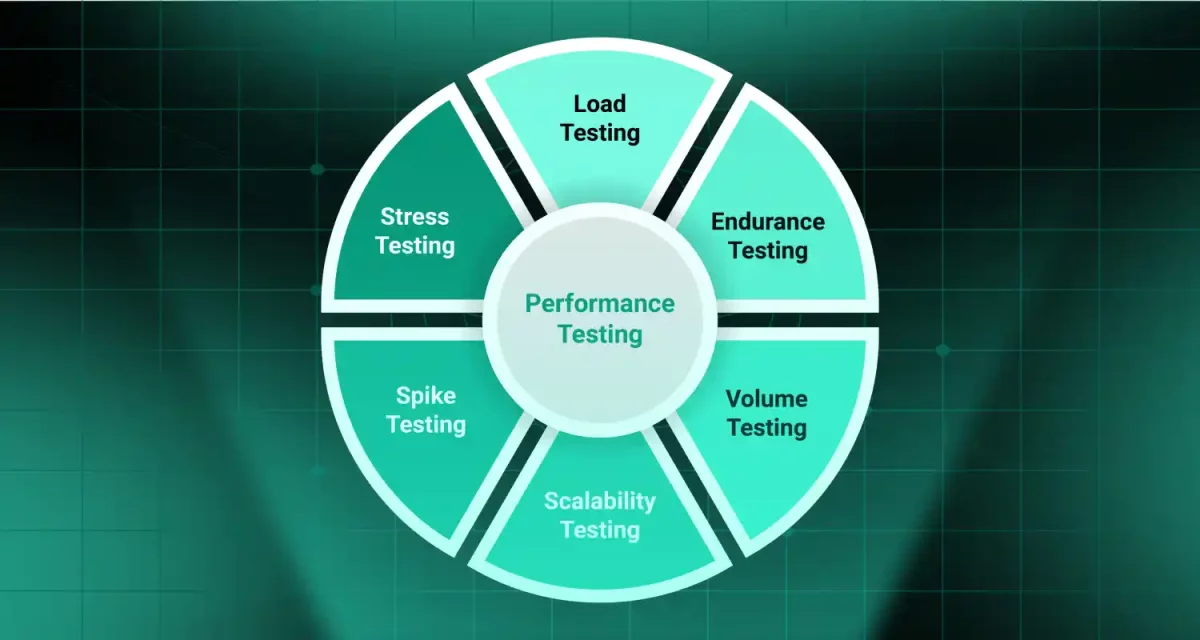
Software development has evolved, and traditional methods struggle to keep up with fast-changing requirements. This led to the rise of Agile methodologies, which focus on flexibility, teamwork, and continuous improvement.
One of the most popular Agile frameworks is Scrum software development. It organizes work into short cycles called sprints, helping teams plan, build, and improve efficiently. With defined roles and structured events, Scrum enhances collaboration and product quality. In the following sections, we’ll explore how Scrum software development works, its benefits, and challenges.
1. What is Scrum in Agile software development?
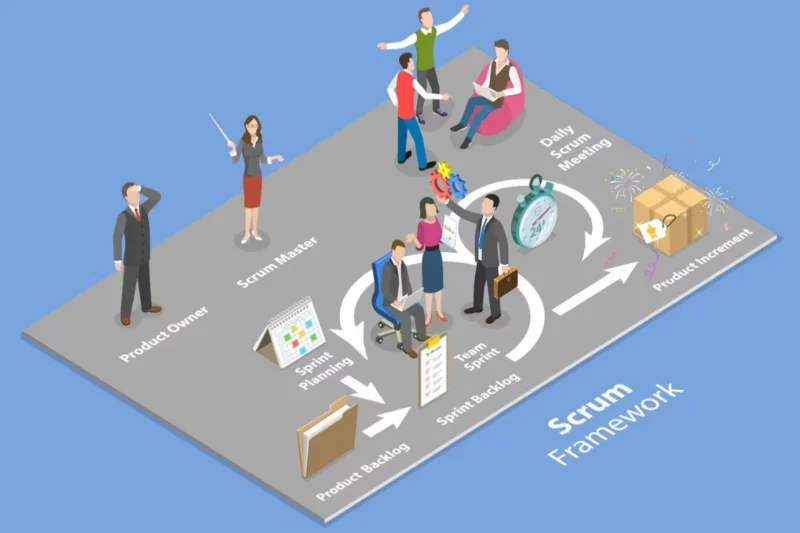
1.1. Definition
Scrum software development is an Agile Scrum framework that helps teams work efficiently in fast-changing environments. It was first introduced in the 1990s by Jeff Sutherland and Ken Schwaber as a better way to manage complex projects. Inspired by Agile methodologies, Scrum focuses on flexibility, collaboration, and continuous improvement.
1.2. Core principles and values of the Agile Scrum framework
The Agile Scrum framework is built on key principles: adaptability, transparency, and customer-focused development. It follows five core values: commitment, courage, focus, openness, and respect. These guide teams to work effectively and deliver high-quality products.
1.3. How Scrum fits into Agile methodologies
Scrum is a structured yet flexible approach within Agile methodologies. While Agile is a broad philosophy, Scrum provides specific roles, events, and processes to help teams stay organized. By using Scrum software development, companies can manage projects in short cycles called sprints, ensuring continuous improvement and faster results.
Read more >>> Spiral Model in Software Development | Definition, Advantages, Disadvantages & Six Invariants
2. The Scrum framework
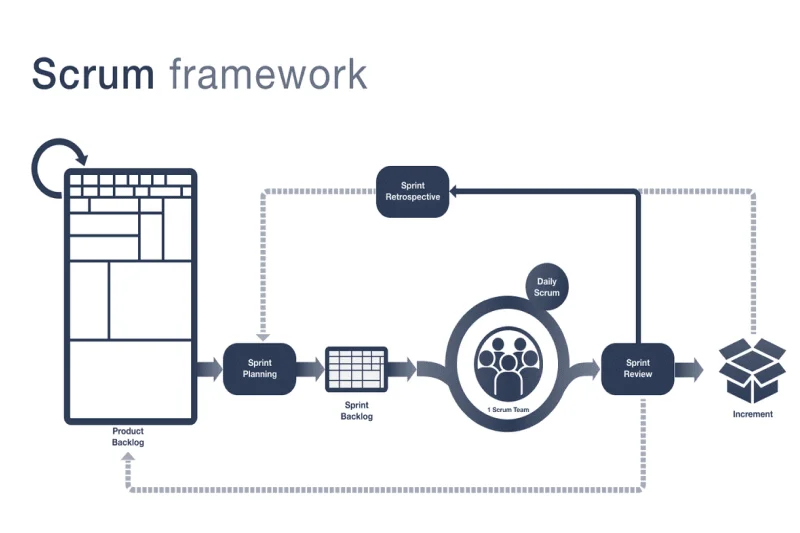
The Agile Scrum framework is a structured yet flexible approach that enables teams to work efficiently in dynamic environments. It offers a clear process for planning, executing, and improving projects through sprint cycles and iterative development. The framework is built around three core elements: Scrum roles, Scrum ceremonies, and Scrum artifacts, ensuring effective collaboration and continuous progress.
2.1. Scrum roles
Each Scrum team has three essential roles, ensuring smooth collaboration and productivity:
- Scrum Master: Acts as a facilitator and coach, ensuring the team follows Scrum principles. They remove obstacles, encourage collaboration, and improve team efficiency.
- Product Owner: Represents the business or customer. They define and prioritize the features in the Product Backlog, ensuring the team works on the most valuable tasks.
- Development Team: A self-organizing group responsible for delivering the product increment. They decide how to accomplish the work and commit to completing tasks within each sprint.
2.2. Scrum ceremonies
Scrum follows a series of structured events, also called Scrum ceremonies, to keep the process transparent and ensure continuous improvement:
- Sprint Planning: The team discusses the Sprint Backlog and decides what work will be completed in the upcoming sprint cycle.
- Daily Scrum: A short, 15-minute meeting where team members discuss progress, challenges, and plans for the day.
- Sprint Review: The team presents the completed work (increment) to stakeholders, gathers feedback, and makes improvements.
- Sprint Retrospective: A reflective meeting where the team discusses what went well, what could improve, and how to enhance future sprints.
2.3. Scrum artifacts
Scrum uses three key artifacts to track and manage work efficiently:
- Product Backlog: A prioritized list of all features, enhancements, and tasks needed for the product. Managed by the Product Owner, it evolves throughout the project.
- Sprint Backlog: A subset of the Product Backlog, containing tasks selected for the current sprint. The team works collaboratively to complete these items.
- Increment: The final output of a sprint. It represents a working piece of the product that meets the Definition of Done and is potentially shippable.
With clearly defined roles, structured Scrum ceremonies, and essential Scrum artifacts, Scrum software development enables teams to deliver high-quality products while staying adaptable to changes.
Read more >>> Shape Up Methodology: A Practical Guide for Software Teams
3. Five Scrum values
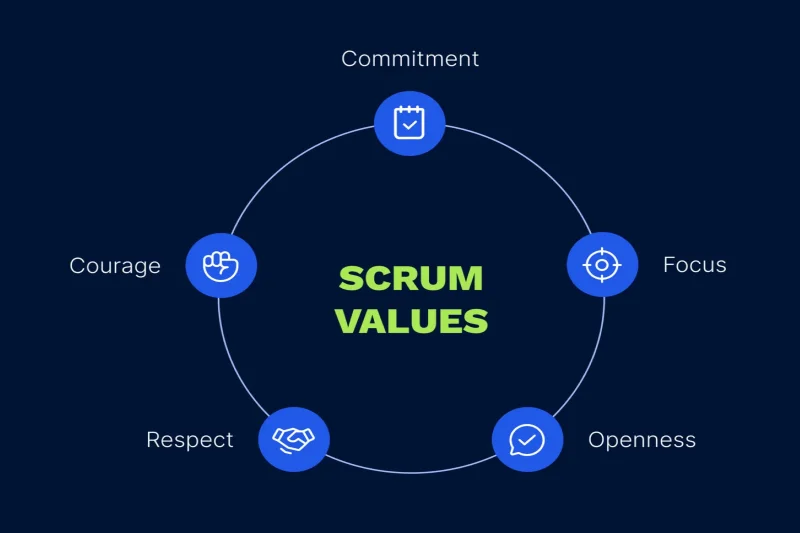
At the core of the Agile Scrum framework are five key values: commitment, courage, focus, openness, and respect. These values guide teams in working efficiently, fostering collaboration, and driving continuous improvement.
3.1. Commitment
Every team member is dedicated to achieving sprint goals. In scrum software development, commitment ensures that tasks are completed on time and meet quality standards. A strong commitment helps teams stay accountable and deliver valuable results.
3.2. Courage
Scrum teams face uncertainty and challenges in every project. The value of courage encourages them to take risks, experiment with new ideas, and tackle obstacles without fear. This mindset helps teams adapt to changes and continuously improve.
3.3. Focus
A key principle of scrum software development is staying focused on delivering value. The sprint goal helps teams concentrate on completing tasks efficiently without distractions. By prioritizing work effectively, teams achieve better outcomes.
3.4. Openness
Transparency is essential in Scrum. Openness means team members share progress, challenges, and feedback openly. This helps improve collaboration and problem-solving, ensuring that the project stays on track.
3.5. Respect
A successful Scrum team values respect. Every member’s input is important, and mutual respect fosters a positive work environment. Encouraging diverse perspectives leads to stronger teamwork and better decision-making.
These five values form the foundation of scrum software development, helping teams work together effectively and achieve continuous improvement in every sprint.
Want to Integrate Powerful IT Solutions into Your Business?
We provide tailored IT solutions designed to fuel your success. Let`s map out a winning strategy. Starting with a free consultation.
Contact UsRead more >>> What is rapid application development?
4. Advantages of the Scrum framework
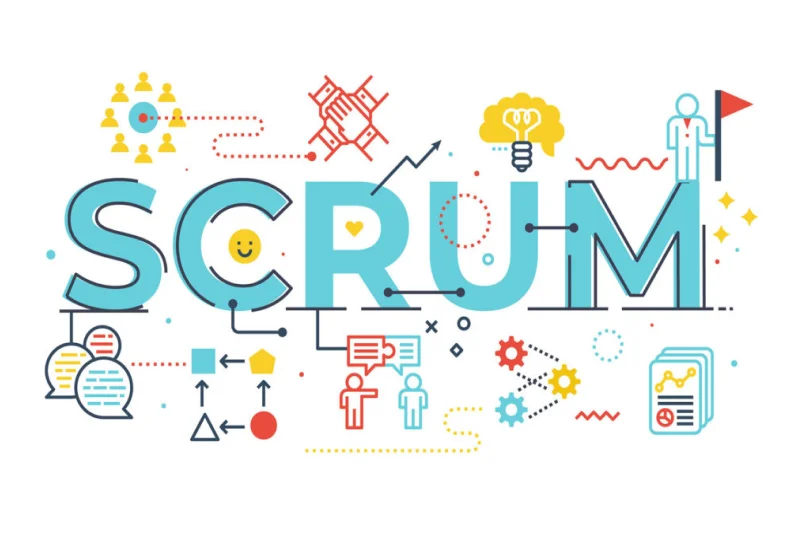
The Agile Scrum framework offers many benefits, making it a popular choice for teams working on complex projects. Its structured yet flexible approach helps teams deliver high-quality products efficiently. Below are the key benefits of Scrum in Agile project management.
4.1. Flexibility and adaptability
Scrum allows teams to respond quickly to changing requirements. Since work is divided into short sprint cycles, teams can adjust their plans without disrupting the entire project. This flexibility is crucial in fast-moving industries like software development.
4.2. Improved product quality
Regular feedback loops help teams identify and fix issues early. Continuous testing and review ensure that each increment meets high-quality standards before moving forward.
4.3. Higher customer satisfaction
Customers are involved throughout the development process. With regular demos at the end of each sprint, they can see progress and provide input. This ensures the final product meets their expectations.
4.4. Better risk management
Short sprints reduce project risks by allowing teams to detect and address potential problems early. Frequent check-ins and planning meetings help prevent costly mistakes.
4.5. Empowered cross-functional teams
Scrum encourages cross-functional teams, where developers, designers, and testers collaborate closely. This improves communication, speeds up decision-making, and fosters innovation.
By focusing on continuous improvement, scrum software development helps teams work efficiently, deliver value faster, and adapt to challenges with ease.
Read more >>> Top 12 Best Cross-Platform App Framework 2025: Which One Wins?
5. Disadvantages of the Scrum framework

While the Agile Scrum framework offers many benefits, it also comes with challenges. Some teams may struggle with implementation, especially in larger organizations. Below are key challenges of adopting Scrum in large teams and other potential drawbacks.
5.1. Requires experienced team members
Scrum works best with skilled and self-organizing teams. Without enough experience, teams may struggle to follow Scrum principles effectively. This can slow down progress and lead to inefficiencies.
5.2. Difficult to scale for large projects
Scrum is designed for small, focused teams. In large organizations, coordinating multiple Scrum teams can be complex. Without proper planning, communication breakdowns and delays can occur.
5.3. Risk of scope creep
The flexibility of Scrum allows for changes during development. However, this can lead to scope creep, where new requirements keep getting added. If not controlled, it can delay delivery and increase costs.
5.4. Requires significant training and cultural shift
Transitioning to scrum software development requires time and training. Teams need to understand Scrum roles, ceremonies, and artifacts. Organizations must also adopt an Agile mindset, which can be challenging in traditional work environments.
5.5. Heavily dependent on team commitment
Scrum relies on teamwork, transparency, and accountability. If team members are not fully committed, the process can fail. Poor collaboration or lack of engagement can lead to incomplete or low-quality work.
Despite these challenges, scrum software development remains a powerful framework. With proper training and commitment, teams can overcome these obstacles and achieve continuous improvement.
Need a Tech Partner Who Truly Gets Your Vision?
From strategy to execution, we`ll partner with you throughout development, delivering clarity, confidence, and measurable results. Get your free project estimate today.
Talk to Our ExpertsRead more >>> The V-Model software development process: Detailed breakdown
6. Conclusion
The Agile Scrum framework is a powerful framework that helps teams work efficiently, adapt to change, and deliver high-quality products. With defined Scrum roles, ceremonies, and artifacts, it provides structure while maintaining flexibility. Its focus on continuous improvement and collaboration makes it a preferred choice for many Agile teams.
While Scrum offers many benefits, it also comes with challenges, especially for large teams or organizations new to Agile. However, with the right training, commitment, and experience, teams can overcome these obstacles and maximize the advantages of the Agile Scrum framework. For projects requiring adaptability and fast feedback, Scrum remains an excellent choice.



